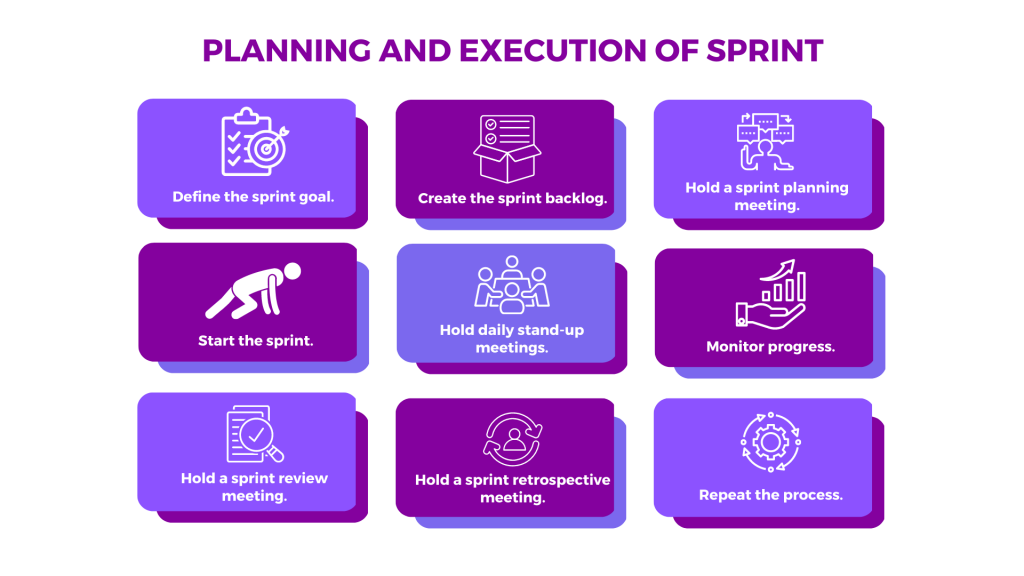
What Is a Sprint?
Definition of Sprint
A sprint is a set of time frames planned by the scrum master. Scrum teams must complete the assigned tasks and make them available for review during this period.
Hello readers, We hope you’re all well! We’ve been seeing questions about this Agile term “sprint,” so we figured We’d share a quick explanation.
The definition of a sprint is a short, time-bound period when a scrum team works to complete a set amount of work. Sprints define the core of the scrum and agile methodologies. An agile team can build a better product with fewer headaches and obstacles with proper sprints and the right time.
In simple terms, a sprint is a set timeframe – usually 1-4 weeks – that a dev team uses to complete a batch of work for a project. At the start of a sprint, they’ll plan out features or tasks they aim to finish before it ends.
In a startup, generally, they do two-week sprints in which they have stand-up meetings where everyone shares what they did yesterday, roadblocks, and plans for the day. This keeps them accountable.
Throughout the sprint, teammates focus solely on completing that iteration’s goals – no feature creep! At the end, they demo what’s done and get feedback. It’s a great way to ship incremental work regularly.
Sprints also have daily stand-ups, burndown charts to track progress, and retrospectives for process improvement ideas at the end. It forces focus but still allows adapting as needed.
Agile frameworks like Scrum commonly use sprints to break large projects into smaller batches. Keeps teams motivated to hit checkpoints and not just grind away for months!
Product owners can break down an agile project into many sprints using product management tools. Teams can understand these sprints as short, repeatable phases, generally two to four weeks long.
The team should decide on the sprints’ number and time at the project’s beginning. A team collaboratively sets their target with the product owner as the “sprint goal” and plans their work in a “sprint backlog.”
Sprint analytics helps the scrum master and product owner get on track with the sprint’s progress at a glance.
What Is Sprint Agile?
Whenever a development team has an agile project, they break it down into small parts. These pieces are known as iterations or sprints in technical terms.
For example, a team has a project that they need to complete in six months. In such a case, the team members in Agile can get overwhelmed with tasks and feel like they need to progress toward the end goal.
But when you divide the project into sprints, the development team can better focus on small goals and witness the project progressing. Splitting in such a way will boost their ability to work toward the end goal without waiting to complete the project.
What Are the Benefits of Sprint?
Focus Better on goals.
The first of the sprint benefits is that it helps teams focus better on goals. Dividing the entire project into an array of smaller tasks ensures that the team’s focus is always on solving the problem.
A ‘definition of done‘ is established beforehand. The teams consider a scrum project sprint as complete only when the final specifications of the product follow the already established definition.
The definition of done refers to the pending backlogs that team members should not consider.
Since everyone knows what to work on, teams become laser-focused and spend their time on the prioritized tasks.
Greater Transparency
Another benefit of Sprint is that it promotes transparency at all levels in the workplace.
The grouping of teams is such that they can be involved in the decision-making process.
Therefore, they all understand the choices made regarding any project. They are also aware of the logic behind crucial decisions.
Since everyone is on the same page, the project’s chances of getting derailed are less. Therefore, it will improve projects’ visibility and transparency.
Higher Customer Satisfaction
The customers are always a part of the project life cycle. They can share their thoughts and give their insights throughout the project.
Involving the target customers helps design the product according to their needs and expectations.
The customer always gets the features and functions of the product that offer value.
By delivering the features requested by the customer, not just in the early stages of the project but continuously throughout the project, one can always keep the customer happy and satisfied.
Following the above guidelines will allow the organizations to retain those customers and increase their business.
Better Product Quality
An organization will have better product quality if it continually checks in with its customers and stakeholders for evolving requirements during sprint reviews. They can determine more quickly whether the product matches their needs.
When it needs to meet their needs, the team can pivot and change directions much earlier and much faster.
Since everything is reviewed almost immediately and on a microscopic level, it can be certain that the product is up to the necessary standards set forth by the PO/PM.
Reduced Risks
One of the best sprint benefits is that they reduce the risks that the teams might face. During an agile project sprint, a project team would encounter almost all kinds of potential issues that could arise in their product.
Hence, they get multiple opportunities to deal with any such situation before it becomes significant.
A member would know any problems other members may face through regular meetings or stand-ups.
Suppose they come across a similar situation in the future. In that case, team members could refer to this time and how their colleagues overcame the problem.
Additionally, teams in sprint agile projects have multiple feedback loops, allowing them to identify and solve problems quickly.
How to Plan and Execute Sprints?
The first step for any agile project sprint is the sprint planning meeting.
Sprint planning is an event where the team has two fundamental questions:
- What work can the teams complete in this sprint?
- How will the chosen work be completed?
The product owner, scrum master, and the development team are responsible for working together and choosing the right work items for the sprint. You must use product management tools to work efficiently and reach the end goal.
The product owner discusses the sprint’s goals and specifies what product backlog items the team should aim to complete to achieve the sprint goal.
The team then designs a plan of action to build the backlog items and get them “Done” in time before the end of the sprint.
They choose work items and the plan of action to get them done. This planning is called the sprint backlog.
After the sprint planning, the team is ready to start the work on the sprint backlog, marking the items from the backlog as “Progress” and then “Done.”
During a sprint, the team discusses the daily scrum or stand-up progress. The primary objective is to avoid any obstacles and issues that could harm the team’s ability to deliver the sprint goal.
After a sprint, the team demonstrates what they have achieved during the project phase in the sprint review.
Such demonstrations will leave space for the team to showcase their work to stakeholders and teammates before it hits production.
The sprint cycle is rounded out with the final meeting, the sprint retrospective.
The sprint retrospective is the team’s opportunity to identify areas of improvement for the next sprint and potential ways to increase the effectiveness of the next sprint cycle.

Key Parts of a Sprint
A sprint has three significant roles: scrum master, development team, and product owner.
Scrum Master
The scrum master is the head of a scrum team. They are responsible for championing a project, providing insights to the team and product owner, and ensuring all team members follow agile practices.
The scrum master addresses all facets of the agile development process and serves the business, product owner, team, and individuals. Scrum Master is also responsible for facilitating communication and collaboration between all these elements.
The responsibilities of this role include:
- Establishing a work-friendly environment where the team can be effective
- Clearing obstacles
- Ensuring a good relationship among the team, product owner, and the other stakeholders outside the team
- Addressing team dynamics
- The scrum master must protect the team against outside interruptions and distractions.
Development Team
A development team is a group of individuals working together to develop and deliver the requested and committed product increments.
It comprises cross-functional members who are capable of achieving the sprint goals. Such cross-functional teams could include people from various domains, such as software engineers, architects, programmers, analysts, system admins, QA experts, testers, UI designers, etc.
- The development team designs the product that the product owner indicates—for example, the application or website.
- The development team includes all the expertise required to deliver a potentially shippable product for each sprint.
- The development team is self-organizing, with a very high level of autonomy and accountability.
- The development team decides how many items to build in a sprint and the best approach to accomplish that goal.
Product Owner
A scrum product owner is responsible for extracting the product’s maximum value from the team’s work. However, organizations, individuals, and scrum teams may use other methods.
The product owner is also responsible for effective product backlog management, which includes:
- Developing and communicating the product goal to the whole team;
- Creating and communicating product backlog items;
- Ordering of the product backlog items; and,
- Ensuring the product backlog is visible and understood to all the members.
For any successful product owner, the entire organization must respect their decisions.
Teams can reflect on the decisions in the content and ordering of the product backlog. It is also visible in the sprint review.
The product owner is just one person and not a committee. Hence, they can use software like Chisel to manage the product backlog effectively.
The product owner may represent the needs of many stakeholders in the product backlog. The stakeholders or the customers wanting to change the product backlog can do so by trying to convince the product owner.
FAQs
Scrum Master is a role that someone with a job title fills. The usual practice is that the person playing the role of project manager plays the scrum master’s part as well.
Agile development is a software methodology, whereas scrum is one process framework that follows agile.
The sprint backlog comprises the product backlog items the development team gave to finish within the sprint, the plan for doing this, and at least one process improvement.
The scrum team develops a product, and the product owner(PO) maximizes its value. The other responsibility of a PO is to make changes to the product and match it to the product’s vision.
If the product owner is present during the sprint, teams may be able to cover all these things. Even though a PO can interact with the scrum team differently, having their presence during the sprint will help them make clear decisions.
